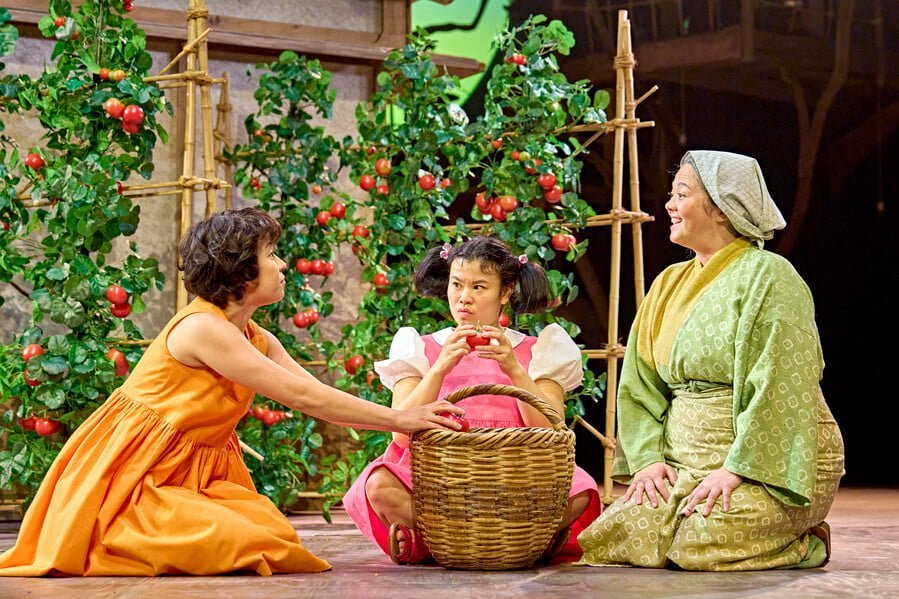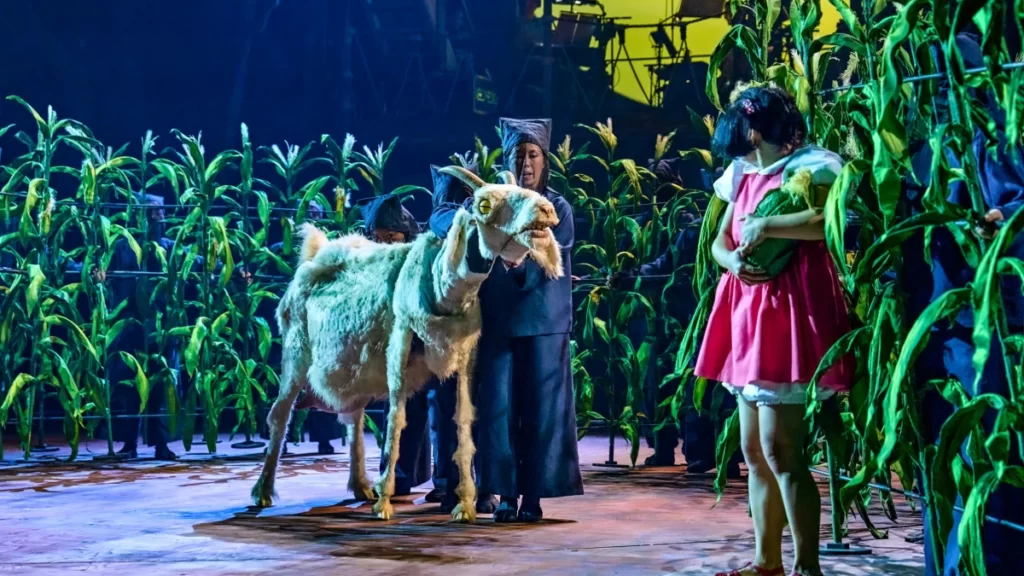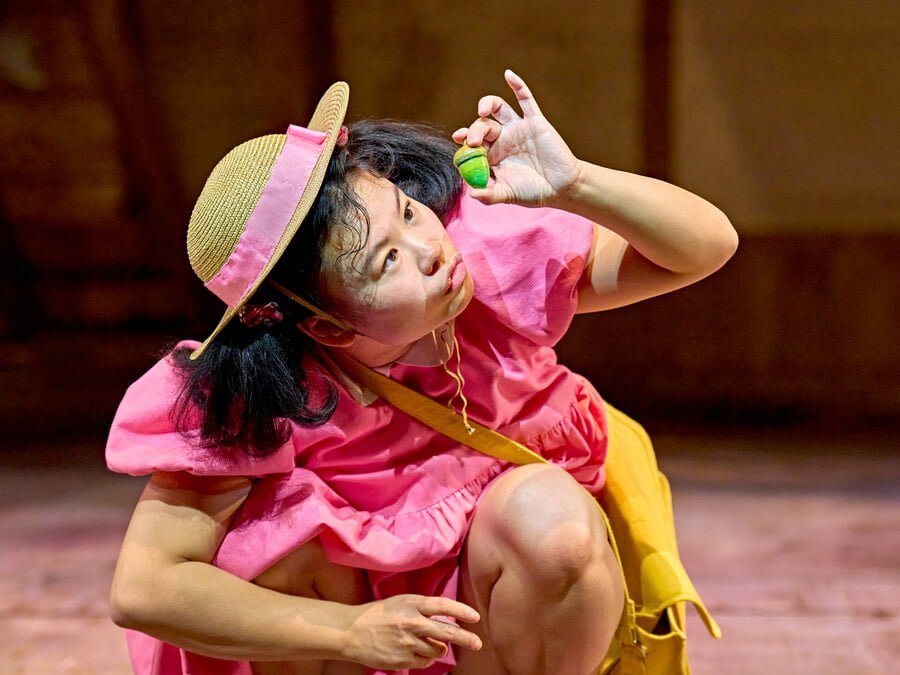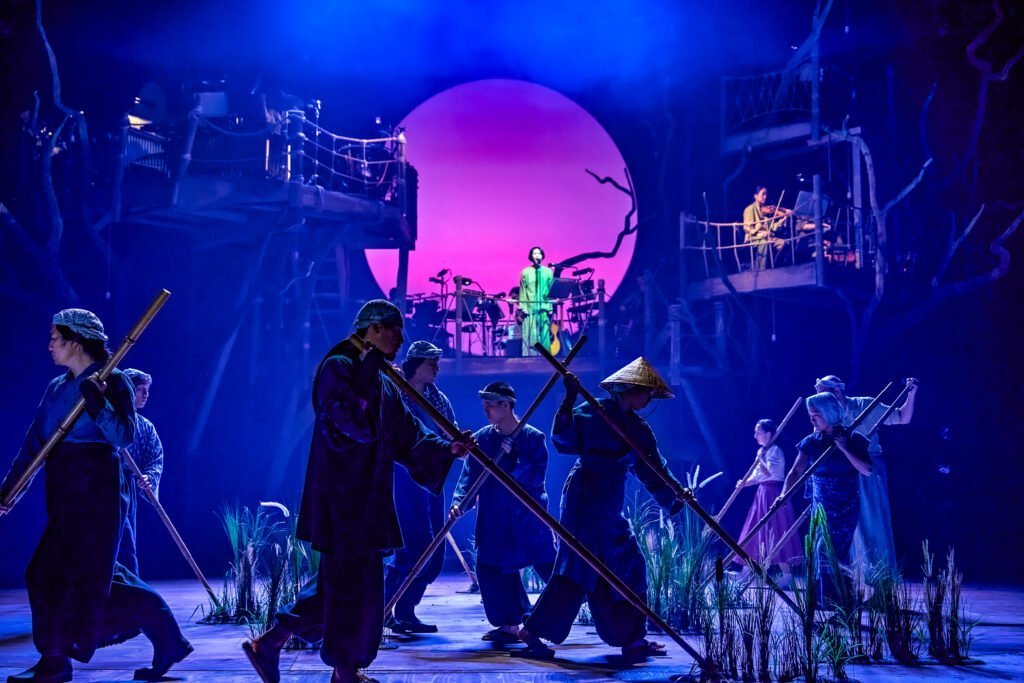Terrific Thrilling Totoro
“You can’t be scared if you’re laughing”
Tatsuo
“I loved the Film but the Play’s even better”
Lyle, our reviewer’s granddaughter

My Neighbour Totoro is a much-loved animation from Japan’s Studio Ghibli. But tonight it is on stage at the Barbican courtesy of the RSC and its associates.
The lives of young sisters Satsuki and Mei change dramatically when their father Tatsuo moves them from Tokyo to a rundown cottage in a rural village to be near the hospital where their mother lies ill. The sisters soon learn the rhythms of the strange natural world, with its acorns and soot sprites. If the human world is less exciting, at least it is warm and supportive with its friendly locals, kindly grandmother figure, pathologically girl-shy teenage Kanta, and a surreal bus driver. The only drawback – for us, as well as the family – is that everyone speaks in dialogue as wooden as the trees in the Great Forest nearby.
In our impatient Western divorced-so-long-from-Nature way we may wonder if something is going to happen. But then younger sister Mei wanders off too far into the woods on her own and meets… Totoro.
“It’s the World’s biggest Bunny!” says Lyle, jumping with glee on seeing the enormous Creature who fills the stage. “I wouldn’t do that if I were you!” she shouts to adventurous Mei, who is already clambering over Totoro, who has a very wide mouth, very large teeth, and a tongue bigger than Mei herself.
When Mei shows no fear, Lyle loves Totoro too. It is hard not to. Totoro is a Giant Wood Spirit, a survivor of the ancients that once flourished in Nature and protected humans, according to Tatsuo. Just as well they did, and still do, as safeguarding is hardly Tatsuo’s strong suit. Since we ungrateful humans have displaced our Protectors with our roads, cities and factories, these once friendly Spirits are hiding from us.

For Totoro languor is the better part of valour and he snores away his life in self-imposed exile with his two (impossible to avoid the word) cute little followers until Mei and Satsui coax the Spirit back into the World. As sparky children sometimes do in fairy tales. Having taken a shine to the sisters Totoro shares an umbrella with them in the rain. And, when this obviously doesn’t work, in a concession to modernity he conjures up a Giant Single-decker Bus Flying Cat to get them home.
So far, so escapist, so fantasy. But the Ghibli world can be very dark. We might easily assume this show is aimed at children, seeing this magical style through the lens of our own fairy tale, pantomime, and even Disney traditions. The late Angela Carter, who knew a thing or two about fairy tales and Japan, quoted a US General, posted there in the post-war years, as saying, “You can go for ages thinking that these people are naive and child-like… Then they’ll surprise you with something that makes you realise their culture is far more ancient and sophisticated than ours.” Somewhat patronising, she said, but with a large grain of truth.

Totoro is the ‘something’ in the first act. But in the second the surprise is an elemental shriek of pain that rips through all the cosiness to fill the auditorium. A cry of despair at the realisation of imminent, irreparable loss. (Made all the more real by the utter conviction of Ami Okumura Jones and Mei Mac as the sisters. One trying to release her own pain by hurting the other.) Suddenly the thing not spoken of before comes to the front of the stage. Suddenly we have drama. So perhaps Totoro’s role is to comfort those facing bereavement.
Of course this is Life. This is Nature too. It cannot be taken for granted. Bad things happen. As some in the audience may know at first hand. But this sequence is done with such power that, for me at least, it was tonally out of keeping with what had gone before. While a TV or cinema screen can project powerful emotion the whole point of theatre is to amplify it. And this show does. Fair enough for genuine tragedy, but for big-eyed giant rabbits and giant mutant cats? For any child or adult who has been in this situation this might feel like a manipulation. A cheap effect. And all the more so for being so well done. But when Totoro’s tiny furry chums with their cute button eyes wobble their way onto the stage the bathos is palpable. This is more like a violation of private feelings rather than a meditation on the power of Nature.

But if this show is now beyond a happy ending, we get one anyway. The Giant Flying Cat Bus is conjured up to help make all well. “Everything is going to be all right.” And it seems to work. The glowing finale is treated to a standing ovation which the cast and crew certainly deserve.
As do the designers and managers of the set which can turn into a forest as trees drop from above or a field full of corn which appears as if by magic. The music performed by a brilliant ensemble suspended high above us in the tree tops is subtle and apt, bar the odd cheesy song. And the Puppeteers are magnificent. Not only do they bring the gargantuan Totoro and the Flying Cat to life but also a host of other creatures. In fact it is the gaggle of hens that tease poor Kanta which gets the biggest laugh. The puppets themselves are from the Jim Henson Creature shop by Basil Twist.
My Neighbour Totoro is a brilliant machine made of People, Puppets and Plants.
Lyle wants to go down to the stage to thank all the people in person. But has to be content with clapping along with the rest of us.


Production Notes
My Neighbour Totoro
Written by Hayao Miyazaki
Adapted by Tom Morton-Smith
Directed by Phelim McDermott
Cast
Starring:
Arina Ii
Dai Tabuchi
Haruka Abe
Haruka Kuroda
Jacqueline Tate
Kanako Nakano
Li-Leng Au
Matthew Leonhart
Mei Mac
Michael Phong Le
Si Rawlinson
Susan Momoko Hingley
Zachary Hing
Nino Furuhata
Boaz Chad
Andrew Futaishi
Yojiro Ichikawa
Ami Okumura Jones
Aki Nakagawa
Tobi Poster-Su
Shaofan Wilson
Marian Lee
Creatives
Director: Phelim McDermott
Composer: Joe Hisaishi
Movement Director: You-Ri Yamanaka
Set Designer: Tom Pye
Costume Designer: Kimie
Nakano
Puppet Designer: Basil Twist
Musical Director : Matt Smith
Lighting Designer: Jessica Hung Han Yun
Sound Designer: Tony Gayle
Video Designer: Finn Ross
Producers: Improbable,
Joe Hisaishi,
Nippon TV,
Royal Shakespeare Company
Information
Running Time: Two hours 40 minutes with an interval
Booking until 21st January 2023
Theatre:
Barbican Theatre
Barbican Centre
Silk Street
London EC2Y 8DS
Box Office:
Barbican Website: www.barbican.org.uk
Tube: Barbican or Moorgate
RSC Website: www.rsc.org.uk
Reviewed by Brian Clover
at the Barbican Theatre on 25th October 2022

